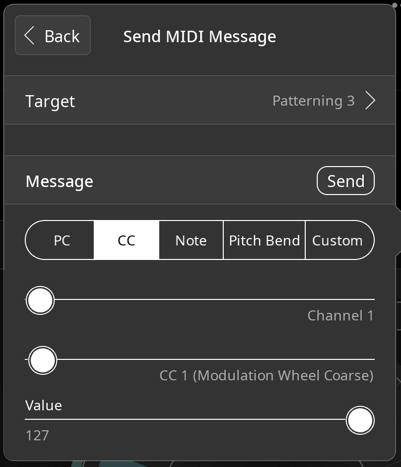Loopy Pro: Create music, your way.
What is Loopy Pro? — Loopy Pro is a powerful, flexible, and intuitive live looper, sampler, clip launcher and DAW for iPhone and iPad. At its core, it allows you to record and layer sounds in real-time to create complex musical arrangements. But it doesn’t stop there—Loopy Pro offers advanced tools to customize your workflow, build dynamic performance setups, and create a seamless connection between instruments, effects, and external gear.
Use it for live looping, sequencing, arranging, mixing, and much more. Whether you're a live performer, a producer, or just experimenting with sound, Loopy Pro helps you take control of your creative process.
Download on the App StoreLoopy Pro is your all-in-one musical toolkit. Try it for free today.
Midi setup to control drum machine
I’m drowning in an ocean of information browsing this. It’s probably very obvious and I only need some basic information to get me going. But I’m obviously missing something.
I have patterning 3 running within loopy pro ( beta). How exactly can I set things up to control functions and parameters of pattering with knobs and sliders?



Comments
Are the functions you want to control available as Audio Unit parameters or are they things that require Patterning’s own midi learn?
Here is one method to see if AU parameters are available
Patterning shows actions and targets indeed, but not for transport and not for pattern presets and is only listening for events and doesn’t show any CC numbers. I need a virtual midi in, as I assume, with patterning as its destination? But even with that I just cannot get there. It looks like I could use external hardware and patterning would listen to that. But all I wanna do is to have a button in Loopy to select pattern presets of patterning.
😱😆😆 quite lost
To send midi to an AU make the AU itself thd target.
@Zsolt : you may want to look at Patterning’s midi learn instructions. It definitely works but its maybe not obvious.
It is indeed a little confusing how to select patterns via midi in Patterning 3.
One way I've found so far is to set up buttons for next and previous in Loopy Pro, each sending a different CC, with Patterning 3 as the target. Then in Patterning 3, tap the next pattern (
>>) button, then the midi learn button, then the button that was set up for Next. With midi learn still engaged, tap P3's previous pattern button, then the Loopy button that was set up for previous pattern.If you need more detail than that, please let me know.
Here's the setup for the Next Button:

Confusing indeed – but hey, someone over in reddit posted the solution today
Other knobs and sliders should follow a similar pattern. For instance, to control P3's Delay level with a Loopy slider, set up the slider to send a midi CC to Patterning 3. Tap the P3 Delay level fader and engage midi learn in P3, then move the Loopy slider. Finally disengage P3 midi learn.
Now I think I’ll get there // thanks a lot for support everyone
There's a serious shortcoming in the midi learn approach however. Loopy can't provide feedback for Send MIDI actions because it has no way of knowing how the sent midi relates to what's going on in the app or hardware if the target doesn't provide midi feedback. It also doesn't save the control's last value for that same reason.
A better way of control is usually to use AUv3 parameters. Those provide state feedback and are saved with the session. To use AUv3 parameters, you set up your widgets to use
Adjust Audio Unit Parameteractions instead.P3 exposes many parameters. However, it doesn't expose the pattern selection. So midi learn is needed for that. That's why I started off with Send Midi examples.
Yes MIDI learn is the way.
I struggled with how to best implement pattern select with AU parameters so I left it in MIDI learn until I could find some clarity.
If anyone knows an example of an app that does this particularly well, let me know!
A CC type of control didn’t make sense for obvious reasons. I guess an “indexed” one would be the “correct” way except that the parameter tree would need to be refreshed every time a pattern is created or deleted. I don’t trust hosts to handle that well, and I could see various problems on the host end anyway, for example if the number of patterns changed after some automation were written in.
Another option is to not use AU parameters but, like the triggers, have a default mapping of notes or PGM changes that correspond to pattern indexes.
@benkamen : default mapping notes would get my vote. They are pretty convenient.
My only real concern is that it could be confusing with both notes and patterns using notes. I’d put it on another channel but I know that Ableton, for example, doesn’t allow multiple channnels sent to an instrument device, as far I can tell.
I wonder if putting them starting at note 0 would put them out of the way of notes to trigger samples